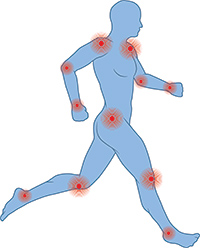Maintaining joint health should be a daily focus for athletes. Joint health is a complex issue for everyone, but for athletes it poses a greater concern. The constant, intense strain on joints from athletic involvement sets the stage for joint inflammation and ultimately degeneration.
Multivitamins
A multivitamin / multimineral should be part of an athlete's foundational nutrition. They should be from a reputable source, which would make them certified from GMP (Good Manufacturing Practice), NSF (National Sanitation Foundation) or TGA (Therapeutic Goods Administration).
An optimal multivitamin / multimineral will have vitamin E, carotenoids, zinc, magnesium, copper, a full complement of B vitamins, and microcrystalline calcium hydroxyapatite (MCHC) for the calcium component. MCHC has been shown to not only prevent bone loss, but also promote bone growth.1-3
Numerous studies on omega-3 fatty acids indicate they improve cardiovascular profiles. Two grams of EPA-DHA, when taken daily, reduced pain in almost 60 percent of patients with neck and lower back pain.4-5 Consumption of omega-3 may decrease acute chronic pain and inflammation – a serious problem as a result of long-term athletic performance.6
Proteolytic Enzymes
Studies suggest patients who receive proteolytic enzymes experience reduced swelling, pain and inflammation, as well as faster recovery rates from injury.7 Proteolytic enzymes include trypsin and chromotrypsin, which are often coupled with bromelain. Studies show treatment with bromelain resulted in a clear reduction in swelling, pain at rest, pain during movement and pain in tender areas.8
In my experience, use of this supplement in a treatment plan within 72 hours of an athletic injury can lead to a faster recovery.
Vitamin D
This is an essential vitamin required by the body for the proper absorption of calcium, bone development, control of cell growth, neuromuscular functioning, proper immune functioning and alleviation of inflammation. A 2010 study found vitamin D deficiency in African-American athletes and athletes who suffered muscle injuries. It was noted that 50 percent of the athletes tested had levels consistent with vitamin D deficiency.
Dr. Scott Rodeo, co-chief of the Sports Medicine and Shoulder Service at the Hospital for Special Surgery, noted that "screening and treatment of vitamin D insufficiency in professional athletes may be a simple way to help prevent injuries." Results of the study were presented at the American Orthopedic Society for Sports Medicine's 2011 annual meeting.9
A 2003 study involved vitamin D-deficient and chronic low back pain subjects who were given 5,000 IU (if less than 110 pounds) and 10,000 IU (if more than 110 pounds) daily. After three months, the 299 subjects who were deemed vitamin D deficient beforehand had reported a disappearance of their back pain. The study also showed that 341 of the 360 subjects were relieved of their chronic low back pain with this vitamin D supplementation regimen.10
An increase in vitamin D intake for athletes has been shown to decrease risk for stress fractures, for which they are at greater risk than the general population.11
Glucosamine and Chondroitin
Glucosamine and chondroitin stimulate the formation and repair of articular cartilage. They have also been shown to reduce pain and inflammation, and slow cartilage loss. A 16-week double-blind, placebo-controlled crossover trial of a combination of 1,500 mg a day of glucosamine HCI and 1,200 mg a day of chondroitin sulfate showed the combination relieved common symptoms of knee osteoarthritis.12-13
Silica
Silicate mineral contains a wide spectrum of minerals and helps with proper absorption of essential nutrients the body requires. It also helps the body use other minerals effectively. A key benefit of this type of mineral complex is the relatively rapid response. An important example of silica's benefit lies in the increased absorption of calcium, which is necessary to prevent bone deterioration.14
Methyl-Sulfonyl-Methane
MSM is a sulfur compound normally found in many of the foods we eat. It is a natural analgesic and anti-inflammatory agent. A double-blind, parallel placebo study was performed using a combination of 500 mg of glucosamine and 500 mg of MSM, three times a day for 12 weeks. The therapy combination showed better efficacy in reducing pain and swelling, and in improving the functional ability of joints, than the individual agents administered alone.
The more impressive result: The onset of analgesic and anti-inflammatory activity was found to be more rapid with the combination than with glucosamine alone, providing more rapid improvement in patients with osteoarthritis.15
ETA Fatty Acids
The fatty acids found in New Zealand green-lipped mussels (eicosatetraenoic acids – ETAs) may play a key role in the reduction of joint swelling due to arthritis. Studies suggest ETA oils from sea mussels are more effective in reducing inflammation than aspirin or ibuprofen.16
A key component of athletic performance and injury treatment is a diet rich in nutrients and quality-controlled, well-researched supplements. The addition of these supplements has been shown to both prevent joint deterioration in athletes and provide rapid response for athletic injury. I'll continue this discussion in part 2 next month.
References
- Epstein O, et al. Vitamin D, hydroxyapatite, and calcium gluconate in treatment of cortical bone thinning in postmenopausal women with primary biliary cirrhosis. AJCN, 1982 Sept;36(3):426-430.
- Ruegsegger P, et al. Comparison of the treatment effects of ossein-hydroxyapatite compound and calcium carbonate in osteoporotic females. Osteoporosis Int, 1995 Jan;5(1):30-34.
- Annefeld M, et al. The influence of ossein-hydroxyapatite compound ('Ossopan') on the healing of a bone defect. Cur Med Res Opin, 1986;10:241-250.
- Maroon JC, Bost JW. Omega-3 fatty acids (fish oil) as an anti-inflammatory: an alternative to nonsteroidal anti-inflammatory drugs for discogenic pain. Surg Neurol, 2006;65(4):326-331.
- Teitelbaum, et al. Effective treatment of chronic fatigue syndrome and fibromyalgia – a randomized, double-blind, placebo-controlled, intent to treat study. J Chronic Fatigue Synd, 2001; 8(2):3-28.
- Siscovick DS, et al. Dietary intake and cell membrane levels of long-chain n-3 polyunsaturated fatty acids and the risk of primary cardiac arrest. JAMA, 1995 Nov 1;274(17):1363-7.
- Tricket P. Proteolytic enzymes in treatment of athletic injury. Appl Ther, 1964;30:647-652.
- Masson M. [Bromelain in blunt injuries of the locomotor system. A study of observed applications in general practice]. [Article in German] Fortschr Med, 1995 Jul 10;113(19):303-6.
- Presented at the American Orthopaedic Society for Sports Medicine's Annual Meeting, July 10, 2011.
- Faraj SA, Mutairi KA. Vitamin D deficiency and chronic low-back pain in Saudi Arabia. Spine 2003;28:177-79
- Cantorna MT, Mahon BD. Mounting evidence for vitamin D as an environmental factor affecting autoimmune disease prevalence. Exp Biol Med, 2004 Dec;229(11):1136-42.
- Hardington T. Chondroitin sulfate and joint disease. Osteo Cart, 1998;6(suppl A):3-5.
- Leffler CCT, Philippi AF, et al. Glucosamine, chondroitin, and manganese ascorbate for degenerative joint disease of the knee or low back: a randomized, double-blind, placebo-controlled pilot study. Military Med, 1999 Feb;164(2):85-91.
- Price CT, et al. Silicon: a review of its potential role in the prevention and treatment of post menopausal osteoporosis. Int J Endocrinol, 2013 Dec.
- Bucsi L, Poor G. Efficacy and tolerability of oral chondroitin sulfate as a symptomatic slow-acting drug for osteoarthritis (SYSADOA) in the treatment of knee osteoarthritis. Osteo Cart, 1998;6(Suppl A):31-36.
- Usha PR, Naidu MUR. Randomized, double-blind, parallel, placebo-controlled study of oral glucosamine, methylsulfonylmethane and their combination in osteoarthritis. Clin Drug Investigations, 2004;24(6): 353-363.
Click here for more information about Robert Silverman, DC, MS, CCN, CSCS.






